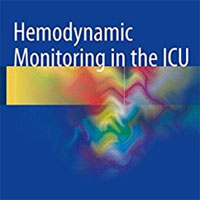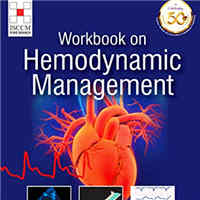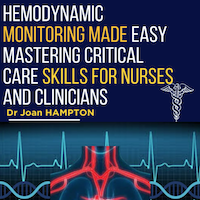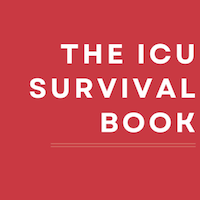Tag: hemodynamics
Anticoagulation Reversal Strategies for Warfarin Associated Acute Gastrointestinal Bleeding
Patients who received prothrombin complex concentrate (PCC) had a threefold increase in mortality compared to fresh frozen plasma (FFP), vitamin K alone, or no reversal, even after adjusting for severity of the bleeding.... read more
Hemodynamic Stabilization Using CRRT and cIVNa Combination Therapy
Compared with conventional continuous renal replacement therapy (CRRT), combination therapy of CRRT and continuous intravenous sodium infusion therapy (cIVNa) increased blood pressure, enhanced urinary volume, and reduced... read more
Hemodynamic Monitoring in the ICU
This book describes the pathophysiological significance of the hemodynamic monitoring parameters available to the clinician and their role in providing reliable and reproducible information on the cardiocirculatory status... read more

Lung-protective Ventilation Strategies for Mechanical Ventilation
This study is an important step toward optimizing mechanical ventilation strategies, addressing the interplay between mechanical power, gas exchange and long-term respiratory outcomes could further refine lung-protective... read more
Increased Sodium Levels Associated with Ceftriaxone Administration
Serum sodium elevation is considered a frequent manifestation in critically ill patients, with significant clinical outcomes and requiring timely management. This case report suggests a possible association between the... read more
Management of ARDS COVID-19 Patients Using Hemoperfusion and CRRT
Combined hemoperfusion (HP) and continuous renal replacement therapy (CRRT) hold promise as a potential intervention for severe COVID-19 cases with multiple organ dysfunction, leading to improved clinical outcomes. Fifty-six... read more
Rapid Clinical Effects of Convalescent Plasma Therapy in Severe COVID-19 ARDS
Administration of convalescent plasma (CP) in critically ill COVID-19 patients leads to a rapid and highly significant improvement of sequential organ failure assessment (SOFA) score along with improvements in respiratory... read more
VAP in Patients with Increased Intra-abdominal Pressure
Critically ill patients with increased intra-abdominal pressure (IAP) and multidrug-resistant (MDR) ventilator-associated pneumonia (VAP) are considered a challenging patient population in every ICU setting. Patients with... read more
Management of Pediatric Septic Shock with Electrocardiometry
Advanced hemodynamic monitoring with EC, in conjunction with clinical assessment, facilitated a restrictive fluid strategy and reduced the incidence of FO. By closely monitoring hemodynamic parameters and tailoring therapy... read more
Septic Distributive Shock: Resuscitative Endovascular Balloon Occlusion of the Aorta
Massive distributive shock can lead to total collapse of the cardiopulmonary system with a subsequent need for CPR. Partial REBOA may be a viable resuscitation adjunct in such cases to restore hemodynamics and increase coronary... read more
The Vasopressor & Inotrope Handbook: A Practical Guide for Healthcare Professionals
An indispensable resource for physicians, nurse practitioners, physician assistants, pharmacists, and nurses in managing critically ill patients. This comprehensive guide delves deep into the world of vasopressors and inotropes,... read more

Diagnostic Value of Chest X-ray in Acute Pulmonary Thromboembolism
This case underscores the diagnostic value of chest X-ray in acute pulmonary thromboembolism (PTE), highlighting the significance of recognizing classical radiographic signs such as Westermark's, Palla's, Fleischner's and... read more
Vasoactive Agents in Cardiogenic Shock Related to AMI and ADHF
Cardiogenic shock (CS) is a heterogeneous condition associated with exceptionally high mortality rates, despite significant advances in the field of cardiology. The primary causes of CS are myocardial infarction-related CS... read more
Mortality Predictor with sPAP in Elderly Critically Ill with Severe COVID-19 Pneumonia
Mortality in general ARDS patients remains high, with many experiencing long-lasting sequelae. Numerous studies have been conducted to identify predictors of mortality in COVID-19 patients, particularly regarding right ventricular... read more
APRV vs. BIPAP Ventilation in COVID-19 Associated ARDS
Despite of higher mean tidal volumes and higher mean airway pressures in airway pressure release ventilation (APRV) vs. biphasic positive airway pressure (BIPAP), both modes did not present an increased risk of volu- or barotrauma... read more
Emergency ECMO Deployment During Liver Transplantation in POPH Patients
Portopulmonary hypertension (POPH) is a challenge in the perioperative setting. Orthotopic liver transplantation (OLT) is a therapeutic option in that setting. ECMO may be necessary for patients with POPH in the perioperative... read more
Hemodynamic Monitoring Using Echocardiography in the Critically Ill
The hemodynamic evaluation of patients with acute circulatory failure and respiratory failure has in the past usually been performed using invasive procedures but in recent years less invasive monitoring devices have been... read more

Workbook on Hemodynamic Management
This workbook focuses on hemodynamics management. Hemodynamic management should be aimed at minimizing the ischemic injury. Cerebral ischemia impairs the brain's ability to autoregulate its circulation through vasoconstriction... read more

Impact of Time to Catheter-Based Therapy on Outcomes in Acute Pulmonary Embolism
Early catheter-based therapie (CBT) was associated with improved clinical outcomes in patients with acute intermediate-risk pulmonary embolism (PE). The composite PE shock score may help identify patients who will benefit... read more
Landiolol vs. Esmolol – Efficacy and Safety in Critically Ill Patients
Landiolol provides superior heart rate control in critically ill patients with tachycardia compared to Esmolol, without increasing vasopressor requirements during the first 24 h. Findings from ScvO2 levels and PCO2 gap... read more
Hemodynamic Monitoring Made Easy: Mastering Critical Care Skills for Nurses and Clinicians
This thorough, simple-to-follow book was created especially for critical care nurses, clinicians, and other healthcare workers to help you fully utilize hemodynamic monitoring. With its straightforward, methodical approach... read more

The ICU Survival Book
The ICU Survival Book is a guide for residents, students, advanced practice providers, and critical care nurses who want to learn the basics of critical care medicine. This reference is designed to follow the systems-based... read more










